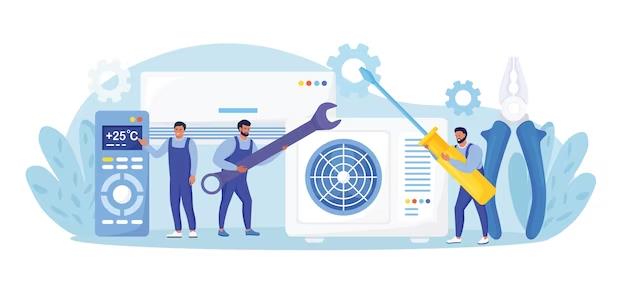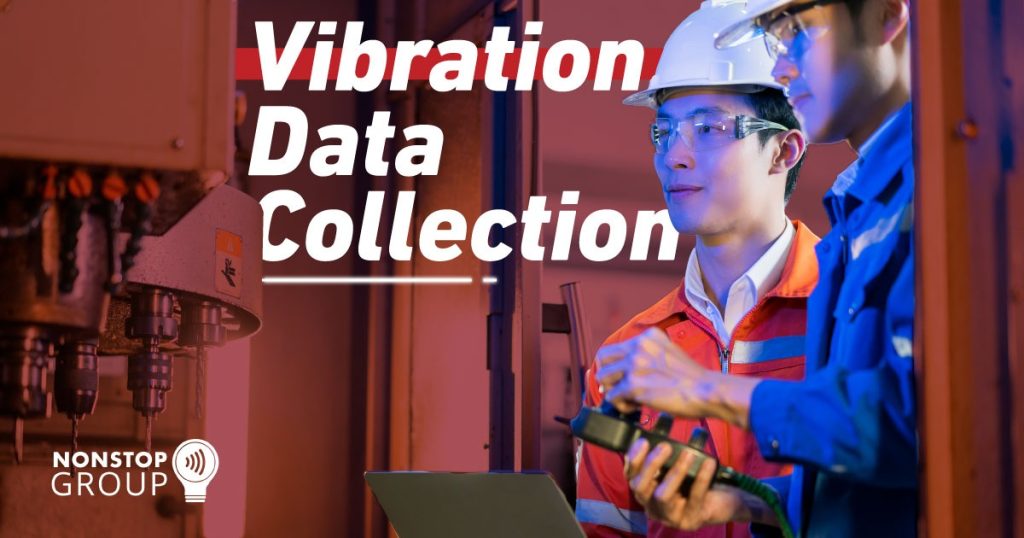6 Min Read

Vibration data collection is foundational to any industrial organization’s proactive maintenance strategy. Employing vibration analysis (VA) offers a quantifiable approach to upkeep industrial machinery and equipment.
When carried out correctly, continuous vibration monitoring empowers your organization to identify potential problems and provide corresponding recommendations to rectify any noted anomalies. Consequently, your facility is facilitated with reduced downtime, enhanced equipment reliability, and optimized machinery performance.
In this comprehensive guide, we will delve deeper into vibration analysis, including how to collect vibration data and the advantages of effective vibration data collection for industrial organizations. Let’s get started!
What is Vibration Data Collection?
Vibration testing and data collection involve measuring and analyzing the vibrations generated by industrial machines, plants, or equipment. The primary objective is to identify and address potential issues with the machinery before they lead to equipment failure or unplanned downtime.
Vibration data can be collected using accelerometers, spectrum analysis, velocity transducers, and displacement sensors. The data collected is then analyzed using various techniques to investigate the vibration levels and patterns that signal abnormalities or potential problems in the machinery.
As a critical aspect of predictive maintenance, vibration analysis enables organizations to assess the equipment’s condition, including its performance, wear and tear, and potential for failure. By regularly monitoring and analyzing vibration data, maintenance professionals can optimize equipment performance, extend the lifespan of equipment, and prevent costly repairs.
What Can Vibration Analysis Detect?

Every time an industrial machine or equipment is in an operational state, it produces some vibration. This machine vibration can be induced by rotating shafts, meshing gear teeth, rotating electric fields, fluid flows, angular rotations, and structural resonance.
Vibration sensors collect this data and record the vibration signals as an amplitude vs. time (time waveform) or amplitude vs. frequency (fast Fourier transform). This vibration data is then deployed in a CMMS for vibration analysts to examine and facilitate failure recognition.
Vibration data aids in the successful diagnosis of common faults in rotating machinery, such as:
- Structural defects
- Bearing failures
- Lubrication issues
- Mechanical looseness
- Resonance and natural frequencies
- Imbalance
- Critical speeds
- Misalignment
- Bent shaft
- Gearbox failures
- Electrical motor faults
- Cavitation (space or bubbles) in pumps
As stated briefly, vibration analysis can provide valuable insights into a machine’s health, allowing technicians to detect and address industrial machinery or equipment anomalies. By analyzing vibration data, maintenance professionals can identify potential issues before they escalate into costly failures or unplanned downtime, improving equipment reliability and optimizing overall efficiency.
Smarter Asset Tracking With NFC Tags
Learn more about how NonStop Suite's NFC Asset Tracking Solution can help your Enterprise streamline operations to new heights.
Get A Free Product Tour
Why is Vibration Analysis Important?
Vibration analysis is an integral part of your organization’s predictive maintenance approach. By leveraging vibration analysis, your organization can streamline the path to a proactive maintenance approach, avoid expensive equipment failures, and enhance your operations’ overall efficiency.
When planned and executed with precision, vibration analysis can yield several advantages for your organization, including but not limited to the following:
- Conducting condition monitoring to predict potential issues and prevent catastrophic equipment breakdowns.
- Enhancing asset performance, preventing unscheduled downtime, and reducing maintenance costs.
- Supporting predictive maintenance by proactively scheduling maintenance and repair activities.
- Decreasing lost production hours and reducing wasted production costs.
- Identifying opportunities to reduce machinery vibration levels and increase efficiency.
Extending equipment life by improving overall reliability, safety, and operational efficacy.
How to Collect Vibration Data?
Collecting vibration data is critical in monitoring the health and performance of machines, structures, and equipment. It is a comprehensive process that begins with installing the right sensor, setting up a data acquisition system, performing the measurement, analyzing the data, and interpreting the results.
When implemented correctly, vibration analysis replaces unreliable, bad data with accurate, useful, good data, empowering vibration analysts to make informed and data-driven decisions. This results in improved maintenance planning, increased equipment reliability, and enhanced efficiency.
Detailed below are the two primary methodologies used to collect vibration data:
1. Manual Vibration Data Collection
This data collection method is largely human-dependent. Trained and skilled personnel download routes manually from software on a computer onto a data collector.
The data collector is carried from one piece of equipment to another to collect data from each designated location on a machine. This data is collected at average intervals while the machine is operating under normal conditions. Once the data is gathered, the vibration sensor device is linked to the computer, and the routes are deployed into the software for vibration analysis.
The collected vibration data and generated reports are generally exported or shared across the departments via emails.
2. Automated Vibration Data Collection
As the name suggests, automated data collection largely depends on automated software and programs and requires minimum personnel involvement.
In this method, accelerometers are permanently mounted on machines. These accelerometers are also terminated into data acquisition units where the data is processed at predefined intervals, depending on the criticality of the machine.
Since the data is automatically collected and processed, it is readily available for the facility managers, technicians, and stakeholders to view and take action as needed.
Differences Between Manual and Automated Vibration Data Collection | ||
| Manual Vibration Data Collection | Automated Vibration Data Collection |
Method | Data is collected manually using handheld vibration meters or analyzers. | Data is collected automatically using sensors connected to monitoring systems. |
Frequency | Typically done periodically, often at predetermined intervals or when vibration issues are suspected. | Can be done continuously or at regular intervals, depending on the monitoring system. |
Accuracy | May be affected by human error or variability in the quality of data collection techniques. | Generally more accurate and consistent due to standardized data collection methods. |
Coverage | Limited coverage due to the need for manual data collection; often, only selected equipment or locations are monitored. | Wider coverage is possible, for example, with sensors placed strategically throughout the facility to monitor various equipment. |
Cost | Relatively low cost for equipment and training. | Higher upfront costs for sensors and monitoring systems that may result in cost savings in the long run through improved maintenance practices. |
Time and Effort | Can be time-consuming and labor-intensive, particularly for large facilities or complex equipment.
| Requires less time and effort, as the monitoring system can collect data automatically. |
Data Analysis | Data may need to be manually entered into analysis software for further processing. | Data is typically automatically uploaded to a centralized system for easy analysis and interpretation. |
Maintenance | Requires regular maintenance and calibration of equipment. | Monitoring systems require regular maintenance and may need an occasional recalibration of sensors. |
Benefits | Provides a basic understanding of equipment health and can be useful for identifying obvious issues or trends over time. | Can provide real-time data on equipment health, allowing for proactive maintenance and early detection of issues. |
Limitations | Limited data coverage and potential for human error or bias. | Can be expensive and may require technical expertise to maintain and interpret the data. |
Pro Tip Integrate the NonStop Suite into your vibration data collection strategy. This automated solution streamlines asset management and documentation, making it more accurate, efficient, and comprehensive. |
What Tools and Equipment are Used to Conduct Vibration Analysis & Collect Vibration Data?
Vibration analysis uses special VA (Vibration Analysis) monitoring devices and instruments that are largely classified into these two types:
1. Fixed Data Collector
Fixed devices are typically installed on heavily utilized equipment and machinery that is challenging to monitor constantly, such as high-speed equipment like compressors or turbines. These machines are often located in inaccessible areas and pose a high risk of damage if potential issues are not addressed promptly.
To mitigate these risks, installing fixed data collectors on critical equipment is a smart move. These devices provide continuous data that can be translated into data-driven reports and actions, making it easier to monitor and maintain the equipment effectively.
2. Portable Data Collector
The portable data collector is a lower-cost solution than fixed data collector devices. It typically consists of a small handheld unit with sensors like accelerometers and proximity probes. These vibration sensors detect and measure vibration levels and frequencies.
Facility managers use portable devices to move around, collect data from different locations and measure several points with one machine or sensor.
PRO TIP Upgrade to a modern, high-performance, optimized data collection procedure using the NonStop Suite. This smart asset management solution brings your vital data, documentation, reporting, and analysis into an Enterprise Asset Management (EAM) cloud, allowing you to effortlessly gather, process, share, and collaborate on data within a centralized database. |
Integrate The NonStop Suite To Streamline Your Vibration Data Collection & Analysis!
Collecting vibration data is crucial for maintaining critical equipment, ensuring operational excellence, and complying with safety standards. The NonStop Group offers a smart solution called The NonStop Suite to simplify and systematize vibration analysis.
The NonStop Suite is a comprehensive package of cloud-based asset-management tools, including Dynamic e-Forms, Smart NFC tags, enterprise-level compliance, and cloud-based EAM. These features enable organizations to gather, process, analyze, and report accurate and reliable vibration data in real time.
By using this streamlined and hassle-free data processing, facilities can proactively address potential issues before they escalate into major problems, resulting in cost savings on reactive maintenance and repairs.
The NonStop Suite is customizable to meet the requirements of organizations looking to collect data from a single machine or multiple machines across a range of different locations. With advanced algorithms and machine learning capabilities, The NonStop Suite optimizes maintenance strategies and boosts efficiency, ultimately prolonging equipment lifespan.
Upgrade your vibration data collection process with The NonStop Suite for a simpler, smarter, faster, and more efficient solution. Contact The NonStop Group today to schedule a FREE personalized product tour.


